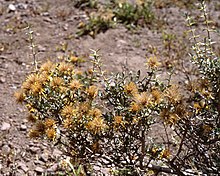Barnadesioideae
Appearance
| Barnadesioideae | |
|---|---|

| |
| Chuquiraga oppositifolia | |
| Scientific classification | |
| Kingdom: | |
| (unranked): | |
| (unranked): | |
| (unranked): | |
| Order: | |
| Family: | |
| Subfamily: | Barnadesioideae K.Bremer & R.K.Jansen
|
| Tribe: | Barnadesieae |
| Genera | |
|
9, see text | |
Barnadesioideae is a subfamily of flowering plants in the aster family, Asteraceae. It comprises a single tribe, the Barnadesieae. The subfamily is endemic to South America. Molecular evidence suggests it is a basal clade within the family,[1][2] and it is monophyletic.[3]
The subfamily includes species of annual and perennial herbs, shrubs, and trees up to 30 meters tall. Most are likely pollinated by hummingbirds.[3]
As of 2009, there are nine genera, for a total of approximately 91 species.[3]
Genera include:[3]
References
Wikimedia Commons has media related to Barnadesioideae.
- ^ Urtubey, E. and T. F. Stuessy. (2001). New hypotheses of phylogenetic relationships in Barnadesioideae (Asteraceae) based on morphology. Taxon 50(4) 1043–66.
- ^ Timme, R. E., et al. (2007). A comparative analysis of the Lactuca and Helianthus (Asteraceae) plastid genomes: identification of divergent regions and categorization of shared repeats. American Journal of Botany 94(3) 302–12.
- ^ a b c d Gruenstaeudl, M., et al. (2009). Phylogeny of Barnadesioideae (Asteraceae) inferred from DNA sequence data and morphology. Molecular Phylogenetics and Evolution 51(3), 572-87.
